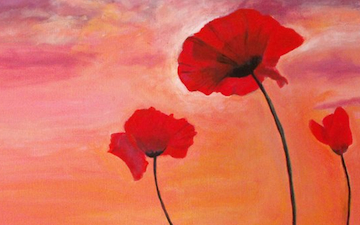Papaver rhoeas (common names include corn poppy, corn rose, field poppy, Flanders poppy, red poppy, and red weed) is a species of flowering plant in the poppy family, Papaveraceae. This poppy, a native of Europe, is notable as an agricultural weed (hence the “corn” and “field”) and as a symbol of fallen soldiers.
P. rhoeas sometimes is so abundant in agricultural fields that it may be mistaken for a crop. The only species of Papaveraceae grown as a field crop on a large scale is Papaver somniferum, the opium poppy.
The plant is a variable annual, forming a long-lived soil seed bank that can germinate when the soil is disturbed. In the northern hemisphere it generally flowers in late spring, but if the weather is warm enough other flowers frequently appear at the beginning of autumn. The flower is large and showy, with four petals that are vivid red, most commonly with a black spot at their base. Like many other species of Papaver, it exudes a white latex when the tissues are broken.
It is known to have been associated with agriculture in the Old World since early times. It has most of the characteristics of a successful weed of agriculture. These include an annual lifecycle that fits into that of most cereals, a tolerance of simple weed control methods, the ability to flower and seed itself before the crop is harvested.
The leaves and latex have an acrid taste and are mildly poisonous to grazing animals.
Its origin is not known for certain. As with many such plants, the area of origin is often ascribed by Americans to Europe, and by northern Europeans to southern Europe. The European Garden Flora suggests that it is ‘Eurasia and North Africa’; in other words, the lands where agriculture has been practiced since the earliest times. It has had an old symbolism and association with agricultural fertility.
(From Wikipedia, October 7th, 2010)
– – –
The seedlings of this annual plant appear in spring (1). The flowers, which are present from April to August (5), are visited by a large range of insects, but particularly bees (2). Each plant is able to produce around 17, 000 seeds, these can remain dormant in the soil for 80 years or more, perhaps even as long as 100 years (1). Poppy seeds have been found in Egyptian relics dating from 2,500 BC, and the poppy has been a symbol of death and rebirth since these times; it grows in the fields, is cut with the harvest and always returns the following year (4). The profusion of poppies on the First World War battlefields of Ypres and the Somme struck a chord with all who saw them. The war-churned wasteland of mud, shell holes and broken bodies had been transformed into a dazzling display of wild flowers, healing the land (4). The poem ‘In Flanders Fields’ written by a Canadian volunteer medical officer in Ypres during the winter of 1915 was published around the world. Following the publication of this poem, the practice of wearing artificial poppies to commemorate Armistice Day on the 11th of November became very popular, and continues today. In Britain, the Royal British Legion uses the proceeds from poppy sales to help ex-servicemen and women (4).
(From EOL via Arkive.org)
– – –




